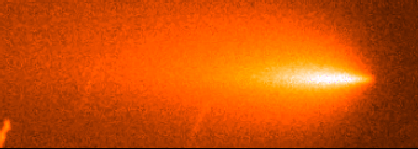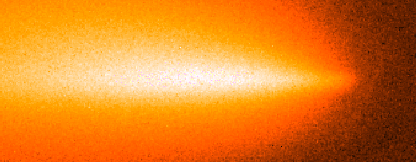Comet LINEAR 1999 S4
Imaging Results from After Breakup
Starting on July 21, observers around the world reported that
LINEAR was exhibiting activity that was unusual, even by this comet's
standards. This activity culminated in the complete disruption of the
nucleus.
First, a long, well-defined plasma tail was seen, lasting for about
two days before it disappeared. Shortly after that, the bright
central condensation started to elongate and fade, until on July 27
there was no longer a bright peak defining the nucleus.
Our Images
We obtained images from Lowell Observatory and Perth Observatory
(the comet was rapidly moving south), on eight nights between July 26
and Aug 10. The full sequence of these images shows the evolution of
the coma and tail after the comet disintegrated, and allowed us to
constrain many of the characteristics of the comet and its
destruction.
Our images from after the breakup consist primarily of
measurements with broadband filters. We did obtain some images with
narrowband filters (see the
photometry page for more information) so we could look at the
morphology of the gas species, but the gas production dropped so
rapidly that all that is visible in these images is the dust. Because
the broadband filters also show the dust, but at a higher
signal-to-noise, we have used the broadband filters for our analysis.
Breakup Sequence

July 26, 2000

July 28, 2000

August 2, 2000
|
This figure shows a representative sample of images
showing the evolution of the tail after the comet disintegrated. These
pictures show how the central condensation faded and became more
elongated with time, with the residual debris slowly dissipating down
the tail. Altough HST images from August 4 showed at least 16
fragments 50-120 meters (160-400 feet) across, the spatial resolution
in our images was not sufficient to resolve any of these subnuclei.
These broadband R images were obtained on July 26, and 28 and August
2. Each box is about 105 km (60,000 miles) long, with the
sun to the right.
|
Dust Tail Modeling
In order to learn about the structure of the comet, we produced
models of the dust tail in the post-breakup images.
- The Model
- We used a Finson-Probstein model that computes the motions of
dust particles under the influence of gravity and solar radiation
pressure. Light acts as a force that pushes the dust grains away from
the sun. Because small particles are pushed faster than large ones,
radiation pressure acts to "sort" the different sized particles into
different regions of the tail. We can model the tail to determine how
many particles of different sizes are present. This gives us
information about what the structure of the comet is like.
- Limitations of the Model
- Because of the nature of light scattering by small particles, very
small dust grains are most prominent in the tail, even though larger
grains contain the majority of the mass. (A 1 cm grain contains the
same amount of mass as 1012 micron-sized grains, but the
ensemple of smaller grains scatters 104 times as much
light.) For this reason, the modeling can only determine the
properties of the less massive dust particles, even though the
majority of the mass is in larger grains.
- Input Constraints
- We used a series of four images for the dust tail models: July 27
and 30 and August 4 and 10. The changes that take place between these
dates provide information about the motions of the dust, adding
further constraints to our models.
- Model Results
- Particle size distribution: In general, the tail after the
breakup has a lower slope than more typical comets. This means that
the ratio of large to small particles is higher than normal, which is
not unexpected given the breakup.
- Emission velocity: The emission velocity was also typical,
at a value of about half a kilometer per second, until shortly before
the breakup, when it dropped rapidly.
- Dust production rate: The production rate started to
increase about July 19-20, and for the larger particles, peaked about
July 21. Small particle production continued for another 2-3 days
beyond that.
Conclusions from Model Results
- The rise in production rates indicates that the onset of the
breakup started on July 19.
- The rise in production rates over several days suggests that the
comet "unraveled" over several days, rather than experiencing a single
explosive event.
- The difference in peak emission for large and small grains means
that there was significant sub-fragmentation. Large grains broke into
smaller and smaller particles over a several day period.
- All of the particles visible in the tail contain a mass
equivalent to about one of the 100 meter cometesimals seen in the HST
images. Thus the amount of mass in the tail was only a very small
fraction of the total.
- Adding up all the mass in the HST fragments plut that seen in the
tail is only a small fraction needed to produce a 0.44-km nucleus. We
therefore infer that the vast majority of the comet's mass ended up in
fragments between 1 millimeter and 50 meters in size (the size range
that is difficult to see).
- Using the amount of dust we compute, and the amount of ice
computed from other studies (published in the May 18 2001 edition of
Science) we find that the comet had very little ice compared to the
amount of dust (the ratio of dust to ice may be as high as 400).
Why did LINEAR break up?
At present it is not known exactly what caused LINEAR to break up.
Several theories have been proposed for why they break up, and we can
look at these individually:
- The comet was hit by a small asteroid
- This is an interesting idea, but there is no evidence for it.
LINEAR was exhibiting outbursts (including fragments coming off the
nucleus) for two months before the final breakup. These precursors
suggest that other mechanisms were responsible for these events.
- A thermal wave propagated into the interior
- In this scenario, heat from the sun propagates into the interior,
heating a pocket of volatile material, which caused pressure to build
up inside the nucleus until it was evetually blown apart. Again, this
is unlikely because of the precursor outbursts and the fact that the
comet seemed to unravel rather than exploding.
- Rapid rotation caused LINEAR to Spin apart
- If the nucleus were spinning fast enough, then centripetal
acceleration could cause it to come apart. We don't have any solid
evidence for the rotation period of the comet (other than our
constraint of less than 12 hours), so this mechanism can't be rejected
offhand. However, the rotation rate would have to be extremely fast
for it to cause the total disruption of the nucleus (a period of less
than an hour). This rapid a rotation is difficult to accept, because
of the fragment seen breaking off in early July. If a piece breaks
off the nucleus, it takes angular momentum with it, thus causing the
nucleus to slow down.
- The nucleus ran out of ices
- This seems to be the most likely explanation, but it does not
explain why LINEAR is different from other comets in that respect. It
is generally believed that ices act as the glue that holds the
components in a nucleus together. LINEAR had little ice compared to
the amount of dust, and once the ice was vaporized, there was nothing
left to hold the comet together. This raises the question of why more
comets are not observed to disintegrate. Is LINEAR different from
other comets, or are all comets essentially the same and others just
need a few more passes around the sun before they come apart?
Return to the LINEAR 1999 S4 Home Page.





